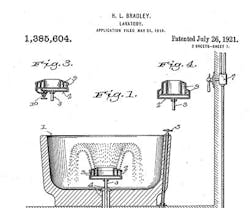So often, many integral designs go unnoticed. They’re just too frequent in our day-to-day to fully take in, and their changes over the years go by without a second thought. And in no other space is that more apparent than the bathroom.
Celebrating its 95th anniversary this year, Bradley Corporation has grown and evolved over the last almost-century to address changes in scientific knowledge, regulations, and trends. Hardly something we think of as we rush out of public restrooms, their washfountain design has blended research and development to provide a time- and resources-saving alternative to the standard sink. Here, we highlight a few of the changes made over the years to address growing concerns in the American market.
Group Handwashing is Born | 1917-1921
Milwaukee-based factory owner Harry Bradley recognized worker handwashing was highly inefficient—long, slow lines resulted in lost production time. In 1917, he introduced a washfountain prototype, which became the first group handwashing patent. The iconic washfountain was introduced to market in 1921 by Bradley Washfountain Company.
The Washfountain Adapts to New Spaces | 1920s
The early washfountain was hand operated, circular in shape, sprayed water upward from the bottom of the bowl, and constructed as one piece. In addition to being sold for traditional heavy-duty industrial hand wash use, the fixtures were also used for flower planters, aquariums, rock terrariums, and even as fresh fruit produce displayers. Taking user feedback into consideration, Bradley introduced foot-operated and wall-mounted models as well, which were quickly incorporated into schools, stadiums, airports, restaurants, and retail shops.
Addressing Germs | 1988
Society’s growing awareness and disdain for germs inspired Bradley to introduce the first touchless technology—Accu-Zone infrared touchless metering control system. The hands-free fixtures allowed users to feel confident they wouldn’t be picking up germs the moment they switched the water off, as well as addressed environmental issues like water-, energy-, and paper-conservation.
Washfountains Evolve to ADA Regulations | 1997 + 2003
The Americans with Disabilities Act—introduced to Congress in 1988 and signed on July 26, 1990—set in motion regulations to make spaces more accessible to users with disabilities. In response, Bradley introduced the first solid surface ADA deep-bowl washfountain for heavy duty handwashing, the Terreon Deep Bowl Washfountain. As the importance of ADA-compliant commercial restroom design rose, the Frequency Lavatory System was introduced in 2003. Combining multiple heights with a unique wave design, the system allowed for broader accessibility.
Sustainability Concerns Come to the Forefront | 2005
With the industry’s broader understanding of sustainability concerns, including water conservation and interest in recycled materials, Bradley created the NDITE Light Powered Lavatory System. The NDITE eliminated electricity use by mounting battery-free panels that power the sink under normal restroom lighting conditions, while providing a 0.5 gallons per minute flow rate, cutting water waste. Additionally, it was made available in their eco-friendly bio-based resin which incorporates pre-consumer recycled granule fillers and other natural materials.
About the Author

Kadie Yale
Former Editor-in-Chief
Kadie Yale holds a BA in Industrial Design from San Francisco State University and a MA in Decorative Art History and Theory from Parsons the New School. In her role as editor-in-chief from 2015-2018, she led the interiors+sources team in creating relevant content that touches on sustainability, universal design, science, and the role of design in society.
